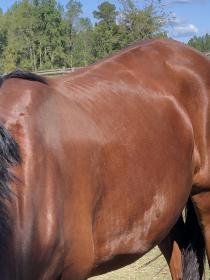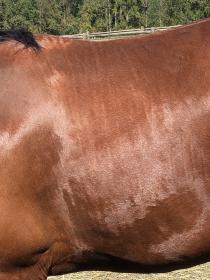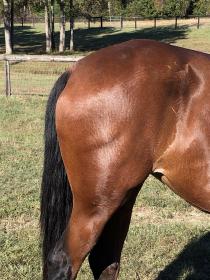Interesting! We have quite the fly season right now so I’ll try to stay after I put him out for a bit and watch.
Rabicano is definitely present in TBs, especially if his sire had a stripy side–check again to see if he has even a few white hairs above his tail. “White ticking” is the more general term. It’s not always as obvious as the pictures online, especially since it spreads with age–so you might start with very little. It’s also not fully understood so there may be a second gene that causes the less obvious version or it may be a second gene interacting with the normal rabicano gene that causes it to be only partially expressed. (Some interesting cases, like High Chaparral who doesn’t seem to be visibly rabicano, but sure threw a lot of rabicano foals…and he sired Dundeel who also wasn’t visibly rabicano but seems to have thrown a lot of rabicano. Possible that the mares were the contribution there, but statistically seems unlikely with so many.)
I had the napping part in mind only if the pattern was more of a wrinkled fur pattern and not a color change, but I loff horses who nap like that.
I’ll check on the white tomorrow when I’m out at the barn! I’ve never seen any but he could have some, he’s not that old so I might’ve just not noticed it before, I don’t look at his bum a lot! The only photos I’ve found of his sire you can’t see behind him, they’re all conformation photos or a racing photo at a front angle.
Is there a layman’s term for this? I don’t know what color to call my TB either. Chestnut coat, dark brown mane and tail and a dorsal stripe. She’s not quite liver chestnut, not quite bay.
My 4yo WB mare has these, but much more pronounced. I’ve always wondered about them. They are on her whole barrel all the way up to her spine, and some over her butt as well. She’s had them for her whole life and they don’t seem to correlate to any sweating, tack, or getting up/down skin fold scenarios. She’s a bright bay and very sleek/shiny coated. Her dam is chestnut and does not have these.
The pattern is very subtle but obvious once you see it. I’ve never seen them in any other horse I’ve owned or ridden.



Ok, Bedford Falls seems statistically unlike to carry rabicano, based on his progeny with pictures on Pedigree Query… There were enough that I would have expected at least some to have clear markings if he carried it and none of them had any clear sign.
You could just say a chestnut with a dorsal stripe if you feel you even need to mentionthe stripe.  Some non-duns (nd1) also have more dun markings on their shoulders and legs, in that case I’d go with primitive markings. They just don’t have the coat dilution like a dun will.
Some non-duns (nd1) also have more dun markings on their shoulders and legs, in that case I’d go with primitive markings. They just don’t have the coat dilution like a dun will.
This post reminded me of a post from a facebook vet group, here is the info copied: what vet Bethany Moats wrote: The lines are called Lines of Blaschko and are a remnant of embryonic cell development. In most animals they are not apparent, but occasionally they are visible when something organizes along the lines, like color, or in this instance, hair growth. Horses with extreme rabicano (color pattern sometimes know as “coon tail”) or vanishing from appaloosa patterns will show color concentrating on these lines, for example. Another case is “brindle” in horses, which is not a genetic color but is a concentration of roan, sooty, or grey along the the lines. It’s unusual that they are visible on your horse, since he is a solid color, but it probably relates to a different pattern of hair growth that is concentrated on those lines.
Holy crap wow! Thank you so much! :eek:
call them his laugh lines 
So I looked at another boarder’s bay horse the other day. He has them too. Same distance of about 1" between them, quite parallel. I will try to get a pic of the grey/white man but not sure how well they will photo on him.
well my curiosity was piqued so I went looking . I wonder if these are fascia attachments in the subcutis. Horses have external abdominal oblique muscles that are spaced approximately along these barrel lines, I wonder if this a connective system skin fascia fat and muscle. It is hard to find info on that wonderful ability of horses to wiggle their skin in response to flies certainly profound in this area.
It is all a mystery
Certainly
